Carro Armato Medio M11/39
 Italy (1939-40)
Italy (1939-40)
Medium tank – 100 built
The first Italian medium tank
The M11/39 originates from a Regio Esercito 1931 specification asking for a “Carro di Rotura” (breakthrough tank). Ansaldo-Fossati responded with a prototype in 1932, heavily influenced by the British Vickers 6-ton design, the Carro di Rottura. These roots were obvious, given the particular suspension and bogie system, but also presented some innovations, like the final reduction gears inside the front-mounted drive sprockets. The second prototype tried an arrangement with 3 boogies having 2 wheels each per side. Later, in the final 1937 prototype, the design reverted back to the original eight road wheels on two paired bogies suspension. It was also fitted with a RF 1 CA radio, not retained for the production run. The 1937-38 prototypes were successfully tried and the army passed an order for 96 units, to be delivered until the end of 1939. FIAT delivered the engine and transmission, but Ansaldo was responsible for the final assembly.
Design of the M11/39
Despite some similarities with the Vickers 6-ton design, the M11/39, this model was not ready yet to receive its main gun in a full traversing turret, despite some attempts made in this direction. The name can be read as thus: M for “medio” (medium), 11 for the weight (in tons) and 39 for the year of entry into service (1939). The main Vickers-Termi 37 mm (1.46 in) L/40 (40 calibers) gun was situated in the main hull, on the right side, while the driver was on the left. It had a limited traverse (15° on each side). The small, fully-traversing turret, was equipped with the usual Breda modello 38 twin 8 mm (0.31 in) machine-gun mount. It was provided a cast gimbal mount coupled with a telescopic sight periscope. The turret armament was intended to counter infantry and other unarmored threats, while the hull-gun had to deal with more important targets. Like the M3 Lee, this transitional solution was a major drawback. The final turret, capable to house the main gun, was ready for the next generation, the M13/40.
The armor was superior to the Vickers design, but still insufficient for a medium tank in 1939. Only 30 mm (1.18 in) on the frontal glacis and turret, 14.5 mm (0.57 in) for the sides, 8 mm (0.31 in) on the rear, and only 6 mm (0.24 in) for the top, turret roof and bottom. The armor was bolted-on, on a riveted construction. Entrances for the crew were situated on the turret, on the main gun roof top, and a large hatch on the left side. There were also air intakes on the rear superstructure and turret, as well as pistol ports on the hull, sides and rear. The driver and main gunner were both located in the forward hull compartment, while the commander was alone in his turret. There was no intercom. The FIAT SPA 8T watercooled diesel engine gave a net power of 105 bhp (125 hp max). It was fed by a main fuel tank (145 liters), and a reserve tank (45 liters). Located at the rear, it drove the front drive sprocket through a long transmission arm. The idler wheels were adjustable. The bogies comprised four sets of paired roadwheels, sprung with a classic semi-elliptic leaf spring.
Production and deliveries
Production started in April 1939, and the first batch was delivered to the Ariete Division, 32nd Tank Regiment, in August, while the 4th Tank Regiment received them later. Initial prospects were to equip each armored battalion with 31 medium tanks. The army affected the bulk of them (72 units) to Libya, while the next batch (24) were shipped to Italian Somaliland. The production ran until mid-1940, and was replaced by the well-improved M13/40. No modification or sub-series is known during this run. The original four prototypes were kept in Italy. Their operational fate is unknown.
The M11/39 in action
Being the first Italian medium tank in service, this model was a clear improvement in the Regia Esercito’s capacities. However, operations during the North African campaign quickly showed some severe deficiencies in the design. The poor positioning of the main gun and the lack of armor were the most vivid issues. Not only was the armor thin, but its appliqué construction added another weakness into its global resistance. It was initially designed to withstand 20 mm (0.79 in) shells. The M11/39 could be easily penetrated by the average British two-pounder guns (40 mm/1.57 in) carried by most tanks and the infantry. The speed was good on flat terrain, but fell quickly due to the torque limitation of the diesel. Plus, this engine was poorly ventilated and often proved unreliable in Africa. However, it proved superior to the British Light Mk.VI and earlier light tank models, as well as the average armored-cars encountered in Eastern Africa. The M11/39s sent there were a real improvement over the CV-33/35 tankettes.
In September 1940, all available M11s in Northern Africa took part in the invasion of Egypt. They took many losses in the process, and were on the defense during the following British counterattack, Operation Compass. Firing from fixed positions, they were destroyed even faster. At the beginning of the siege of Tobruk, in April 1941, the 6th Australian Division Cavalry Regiment managed to recover or capture a dozen of these tanks, which received large Kangaroo symbols to identify them. They served until they ran out of diesel and then placed into fixed positions or abandoned on situ, and blown-off to prevent their recapture by Axis forces. In Eastern Africa, the M11/39 participated in the Italian invasion of British Somaliland in August 1940, and later in the defense of Eritrea. Surviving units were butchered by the few British Matildas deployed there, at the Battle of Keren in January 1941.
Carro Armato M11/39 specifications | |
| Dimensions | 4.70 x 2.20 x 2.30 m (15ft5 x 7ft2 x 7ft6.5) |
| Total weight, battle ready | 11.2 tons |
| Crew | 3 (commander/radio operator, driver, gunner) |
| Propulsion | Fiat SPA 8T, V8 diesel, 105 hp |
| Speed | 32.2 km/h (20 mph) |
| Operational range | 200 km (125 mi) |
| Armament (see notes) | 37 mm (1.46 in) Vickers Termi L40, 84 rounds Twin Breda 38 8 mm (0.31 in) machine guns, 2800 rounds |
| Armor | From 6 to 30 mm (0.24-1.18 in) |
| Total production | 100 |
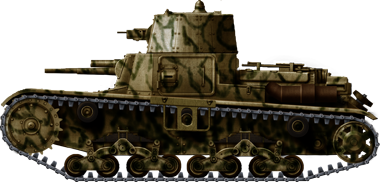
M11/39 in Eastern Africa, British Somaliland invasion, September 1940. It seems the prototypes also had a vermicelli camouflage.
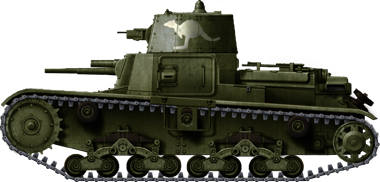
During the first stage of the war in North Africa, the British and Australians managed to push back the Regio Esercito from Egypt, and launched operation Compass in December 1940. This success was accompanied by the capture of hundreds of trucks, guns and tanks. All captured M13/40s and M11/39s were taken over by the 6th Australian Division Cavalry Regiment, which painted their famous large kangaroo of the turret and hull. These fought during most of the siege of Tobruk
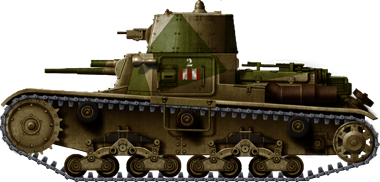
Ariete division, 4th Tank Regiment, 3rd tank of the 2nd platoon of the 1st company, Egypt, September 1940.
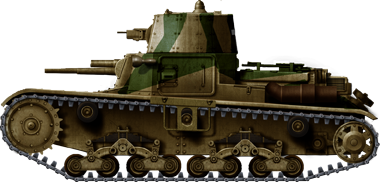
M11/39 of the 1st Armored Battalion, Ariete division, Egypt, August 1940.
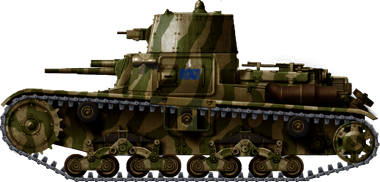
M11/39, Ariete Division, 32nd Tank Regiment, fourth tank of the 2nd company. Libya, 1940.
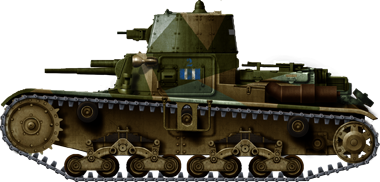
A M11/39 from the 2nd Company of the 32nd Tank Regiment, Ariete division, Libya, early 1941, during Operation Compass.
Links about the M11/39

WW2 Tanks




























WW2 tanks posters

All Tiger tanks liveries.

Panther liveries and variants

WW2 Armour - All tanks











Tanks aces and single tanks series

Find more there

Museums, Movies, Books & Games
The Tanks and Armor in pop culture
Tanks and armored vehicles in general are only really grasped when seen first person: The mass, the scale, it's all there. Explore also the way tanks were covered in the movie industry, in books and in video games.Movies:
Best tanks movie on warhistoryonline.com
On imdb.com
On bestsimilar.com/
miltours.com
liveabout.com/
watchmojo.com
Video Games:
pcgamesn.com
historyhit.com
levvvel.com
vg247.com/best-tank-games
mmobomb.com/
alienwarearena.com
